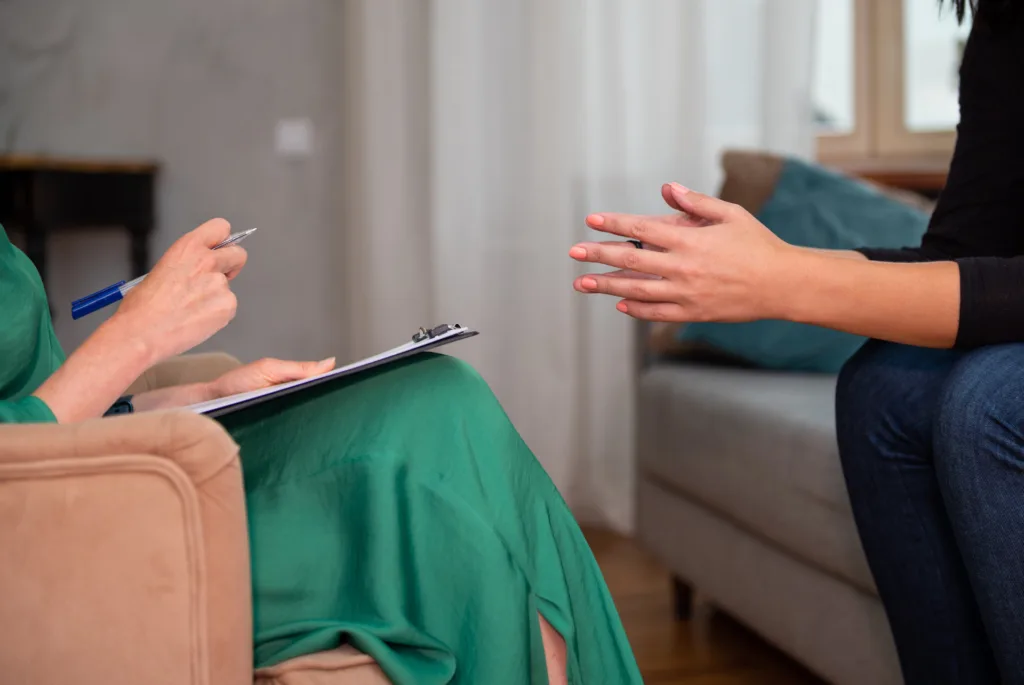Serotonin doesn’t make you happy: How to re-understand the happiness hormone for a happy life
Does serotonin make you happy? Maybe you feel like no matter what you do, how hard you try, you can’t seem to get “out” of sadness. You can’t cheer yourself up, and you feel guilty about it. In this moment, we use a belief – a story – about what we should do to feel better. The false story is that serotonin, the “happiness hormone”, is to blame, and we need to find ways to increase it.
Serotonin is often referred to as the “happy chemical.” The idea is everywhere: from wellness blogs to pharmaceutical ads. But this simplified narrative leaves out something crucial. Happiness, healing, and emotional well-being are far more complex than a single brain chemical.
But here’s the catch: Serotonin does not create “happiness”, despite what you and I are told.
We’ve been sold a “mechanistic view” of serotonin. In this view, serotonin is like a lever we can pull to increase happiness. This incorrect view has led to ironically unhappy outcomes. In this blog, we’re going to look at the neurotransmitter serotonin. We’ll pull apart the assumptions that have kept us from understanding our own needs and propose a more holistic view that will help you achieve lasting happiness.
What is serotonin?
Serotonin is a neurotransmitter, a chemical messenger that helps transmit signals between neurons in the brain. It plays a crucial role in regulating mood, appetite, sleep, and social behavior. It also triggers increased neuroplasticity (our brain’s ability to adapt and learn). While serotonin is often called the “happiness hormone,” it doesn’t simply cause us to feel happy. While it’s present when we experience happiness, we have to be careful about assuming causation.
This begs a few questions about serotonin:
- What is happiness?
- Does serotonin make you happy?
- How does serotonin work?
- If I want to be happy, do I increase serotonin?
Serotonin’s is not a drug that “makes you happy“
As we begin, let’s start by reorienting our view of neurochemicals. Within a Western worldview, we tend to think dualistically about our brains. This means we tend to view our brain as something separate from our “selves”. Further, it’s a way of experiencing the self as a soul-like, unaffected entity that only interacts with our body. A Western worldview sees the brain as a mechanism that causes certain feelings and behaviors in the self.
Someone with a dualistic view of the mind might say, “because my brain was in fight or flight mode, I didn’t feel like myself.” Or again, “my serotonin made me feel happy”. In both cases, we assume two separate entities: the brain and the self. More-so, we assume a causal relationship between the brain’s activity and the self. As such, the cortisol (first example) and the serotonin (second example) “cause me” to feel a certain way. These dualistic assumptions lead to problematic understandings about our happiness. Let’s explore why.
Don’t confuse the cart with the horse, neurologically
Imagine sitting with friends and feeling a bit bored. In an effort to get into a different mood, you exclaim: “Let’s start having fun.” Unless delivered tongue-in-cheek, such a comment is almost certain to result in comically ironic discomfort. Sensing the discomfort, you insist: “Come on, really: Let’s have fun now.” Why doesn’t this work? While these friends are more than capable of having fun, fun is a byproduct, not a cause. Trying to directly infuse “fun” into the interaction misses the point.
In the same way, it’s a mistake to focus directly on increasing happiness through serotonin.
What Serotonin Really Does
Serotonin is a neurotransmitter, a chemical messenger that helps nerve cells communicate. While it’s most commonly associated with mood, serotonin affects many parts of the body. In fact, most of the body’s serotonin lives not in the brain but in the digestive system.
In the brain, serotonin plays a role in helping people feel emotionally balanced, focused, and calm. It supports emotional regulation, which can allow a person to better cope with stress. But it doesn’t cause happiness. Instead, serotonin is part of a much larger network that helps the body and mind maintain balance.
It also plays critical roles in sleep, digestion, appetite, and even wound healing. When serotonin levels are disrupted—too low or too high—it can contribute to a wide range of symptoms, from irritability and fatigue to gastrointestinal discomfort or even serious medical complications.
What Causes Low Serotonin Levels?
There’s no single cause. Sometimes, the body doesn’t produce enough serotonin. Other times, the brain may not use it effectively. Stress, trauma, sleep disruption, poor nutrition, and chronic health conditions can all affect serotonin function. But these biological factors often exist alongside emotional wounds, relationship dynamics, and past experiences that shape a person’s inner world.
The mechanical view of serotonin keeping you unhappy
A quick Google search for “serotonin and happiness” yields a number of articles that celebrate the mechanistic view of serotonin. Here are a few title and subtitle snippets you can find when searching for serotonin:
“Happy Hormones: What They Are and How to Boost Them”
https://www.healthline.com › health › happy-hormone
“Serotonin is often described as the body’s natural feel-good chemical”
“To boost the serotonin levels in your brain you should…”
“The Chemistry of Happiness: Unlock the Power of DOSE to be a happier you!”
https://jainsandeepk.medium.com/the-chemistry-of-happiness-here-is-the-dose-for-a-happier-you-f483f5891d90
“You can also get tiny shots of serotonin by earning likes for your random social media posts. Yet that high is so short-lived that it is hardly worth it!”
In each of these examples, serotonin is treated like a drug we can mechanically increase to “make us” feel good. To be clear: this is not correct.
However, it makes sense that we’re excited by this idea. Our minds can be chaotic, frustrating, and clunky. If we could only “hack” the code we could unlock what we’ve so desperately wanted from our minds: to be content, happy, full of virtue and productivity.
We’re distrustful of biohacking happiness, at least on the silver screen
As much as we’re excited by the idea of “biohacking” our serotonin, we’re equally terrified. Movies such as The Eternal Sunshine of The Spotless Mind, The Matrix, and The Truman Show express both the longing to artificially create happiness, and the dystopian outcomes of these efforts. These stories showcase a godlike effort to “hack” the characters’ experience of the world and effectively pacify a darker reality. Truman is given a safely controlled, domed environment partitioned away from a deceitful world. Neo is shielded from the horrors of a post-apocalyptic planet, and Clementine willfully erases painful memories to help her feel happy again. In each film, the biohack intended to produce happiness backfires. It becomes a “prison for your mind” typifying hell. In each story, the characters reject the biohack in favor of something more “true”.
The lesson? When we reverse engineer happiness, we’re not happy.
In the sections below we’ll re-understand serotonin so you can have a realistic and attainable goal for your own well-being that does not fall into the dualistic, mechanistic trap of chasing a happiness hormone.
The Myth of the “Happy Chemical”
The belief that serotonin creates happiness likely grew from the success of antidepressants, particularly SSRIs (Selective Serotonin Reuptake Inhibitors). These medications increase serotonin availability in the brain and can help some individuals manage symptoms of depression and anxiety.
However, this doesn’t mean serotonin is the single cause of these conditions or that boosting serotonin guarantees emotional well-being. Emotional healing isn’t just a matter of chemistry. It involves relationships, history, nervous system patterns, identity, and lived experience.
Relying solely on the “chemical imbalance” explanation can unintentionally reduce a person’s emotional pain to something mechanical or broken. It may also lead to disappointment when medication alone doesn’t provide lasting change.
Serotonin is not just about feeling happy. Research supports this idea.
A study by Stanford University School of Medicine in 2013 found that oxytocin, the “love hormone,” drives our urge for social connections, and that this in turn triggers the release of serotonin. This chain reaction results in a happy feeling, as serotonin activates the reward circuitry in the nucleus accumbens. A study by the University of Cambridge in 2015 found that low levels of serotonin are associated with lower self-esteem and reduced social status. This suggests that serotonin not only helps us feel connected to others but also influences how we perceive ourselves within our social networks.
Further, the research on the connection between serotonin and social belonging supports what we know about human brain evolution. The Dunbar number is the correlation between the size of a primate’s cortex (the large, energy intensive outer part of the brain) and the size of its tribe. This correlation suggests that the purpose of the cortex isn’t simply to make us “smart”, but to help us attach to a tribe.
Serotonin is a meter of our connection to others
If the need to attach to a tribe is inherent to our survival, would we expect a bodily signal – a sort of meter – that helps us sense and respond to our level of security in the tribe? The body’s answer is a neurotransmitter that responds to our level of connection with others. It’s interesting that the release of serotonin isn’t just connected to the reward centers of our brains, but also opens our brain to learning new behaviors and skills (neuroplasticity). It’s no wonder that when we sense we’re “in” a tribe we also become more moldable to its customs and skills.
Serotonin makes us feel rewarded to be included with others, and it stimulates our brains as if to say, “learn how to be useful to this group.”
This dramatically changes our approach to serotonin and happiness. Happiness itself is not just an internal “feeling”. It’s your awareness that you belong. Much like the feeling you get when you’re at a good family gathering. It’s the feeling of a campfire at the end of a hike, a running team that runs and supports each other every week, a hug with a long childhood friend, the singing of a national anthem at a sporting event, or a group prayer in a place of worship. The feeling is that of being at home.
SSRI’s aren’t all bad…
Increasing serotonin through direct means (such as SSRIs, sun exposure, etc.) still have an important roll. For some people with depression, it’s difficult to accomplish daily tasks. Much like pouring starter fluid in an engine, these methods can dramatically help a person increase their energy. The purpose of this “kick-start”, however, is to help the person build connections and belonging. The stimulation of serotonin receptors can start a positive feedback loop to generate real change.
Reading your serotonin meter
Your body’s serotonin levels swing day to day. 50% of the difference between people’s serotonin levels is a biological set-point. Of the remaining half, we experience a mix between the external world conditions, and our internal way of processing these conditions. For example, if I receive a compliment, that’s an external condition. It may contribute to an increased sense of belonging and self-esteem, thus raising my serotonin levels. But I also make sense of this external condition based on past similar experiences. If I have routinely experienced relationships as flighty or inconsistent, I may immediately reject the compliment. This augments my ability to receive the serotonin experience. In this way, our serotonin levels do not simply reflect our current external conditions. They reflect a combination of our biology, our history of experience, and our current external conditions.

What does high serotonin feel like?
High serotonin is the feeling of self-security. It’s the feeling we described above: home, connected, belonging, part of a team. It carries with it a feeling of “identity” or being grounded in my own body. It couples with the feeling of learning and curiosity. When you feel this way, your body tells you you’re safe and you’re engaged in an activity/behavior/social group that is healthy for you.
What does low serotonin feel like?
In mild cases, low serotonin feels like being bored or understimulated. In Los Angeles (where I’m writing from today), our Western individualist cultural influences tend to carry a mild but constant sense of disconnection from one another. We likely have become used to a relative dearth of connecting experiences. In such a societal structure, such experiences deprive our brains of serotonin.
On first glance, the results are what you’d expect: higher rates than the global average for depression and anxiety. But we also find some milder but common experiences that we come to see as normal. Existential dread, meaninglessness, isolation, and high levels of alcohol and caffeine consumption point to our difficulty coping with adequate social connection.
Low serotonin feels a bit empty. Think of the feeling of “FOMO”, or the experience of waiting for a friend that’s taking too long to show up. It feels uncomfortable. These uncomfortable feelings are your serotonin levels dropping in response to less social connection. Similar to our bodies producing the experience of hunger when we have a need for food, our bodies produce the feeling of loneliness when we’re feeling outside of the circle of our social connections.
How to respond to low serotonin levels
If we focus not on increasing serotonin directly, but listening to our level of serotonin as a social connection meter, we can find new solutions. As we mentioned before, there are two ways we can respond to increase our connections (and therefore serotonin levels): The first is to change our external conditions, the second is to create new ways of making meaning out of those experiences.
Change your external conditions
Let’s start with changing our external conditions. This is usually where we want to start to create a change.
- Coffee Shop Habit. Create normal, small, daily interactions with others you know. One way to do this is to show up at a coffee shop at the same time a few days per week. See if you spot familiar faces. Simply learning a person’s name can help you feel socially connected. Accordingly, other spaces might be a gym or grocery store. Be consistent, patient, and open (maybe no headphones).
- Call a Parent/Grandparent. Checking in with an attachment figure can help you feel connected again. For example, call someone just to say hi. If you have a trusting relationship with a parent or grandparent, a short call can remind you that you belong.
- Call instead of text. Hearing a person’s voice and tone can help you feel connected. This normal, everyday, constant way of being connected is quite low in our digital age.
- Go somewhere social for work. As much as traffic can be inconvenient, studies have shown the social and mental health benefits of being in a social setting for work. For example, if an in-person office is inaccessible, consider setting up shop at a local coffee shop (checking off tip #1 and $4 in one swoop!)
- Schedule regular interactions with friends. Having a scheduled time can help you mind positively anticipate a meeting, thus giving benefits to your social mind before and after the gathering. Some people join a book club, or a CrossFit gym, or a religious study group. Focus on small gatherings, between 3-8 people, and it can be helpful to have an intention besides simply catching up. Play a board game, read a book together, or go on a run.

Is It Possible to Boost Serotonin Naturally?
Yes, but again, it’s not a guaranteed fix. Activities like getting sunlight, exercising, eating tryptophan-rich foods, and reducing stress can all support serotonin levels. Therapy itself may play a role as well, through emotional processing, nervous system regulation, and improved sleep and self-care.
These practices are not replacements for medication when it’s needed, but they are powerful supports for overall well-being. The most effective approach often blends biological, psychological, and relational care.
Serotonin, Trauma, and the Nervous System
People with trauma often experience dysregulation in their nervous system, feeling chronically unsafe, hypervigilant, or emotionally numb. This state can affect the brain’s ability to use or produce serotonin effectively.
Trauma-informed therapy focuses not just on mood symptoms, but on rebuilding a sense of safety in the body and mind. Healing trauma may, over time, support the brain’s natural chemistry — but more importantly, it restores the capacity to feel, connect, and live fully.
How Therapy Helps Beyond Chemistry
While serotonin affects emotional regulation, therapy provides the structure to address what chemicals alone cannot: the underlying causes of emotional pain.
Therapy helps:
- Make sense of past experiences
- Recognize patterns of thinking and behavior
- Strengthen self-compassion and emotional resilience
- Create new, healthier ways of relating to others
- Calm the nervous system through relational safety
These are all things serotonin alone cannot do. When combined with lifestyle changes or medication when appropriate, therapy offers a complete path toward healing and integration.
Healing Is Relational
Serotonin plays a role in mood, but healing from depression, anxiety, or trauma doesn’t come from one molecule. It comes from connection. From telling the truth in a space where it’s safe to do so. From working with someone who knows how to listen beneath the surface.
Therapy is more than symptom relief. It’s a process of integration. Of coming back to yourself. Of understanding what shaped you and beginning to rewire patterns that no longer serve you.
There’s room for medication in this journey. But there’s also room for something deeper: healing through relationship, presence, and insight.
Changing our internal condition
Much more important than the external conditions is our history of experience with the world. Long ago, these experiences dug the channels through which our current experiences flow. While changing our external conditions is important, real change happens when we can see the network of “channels” we hold, and form new pathways. If we do not do this, our external experiences may never yield internal relief.

This process of creating new pathways happens naturally as we experience empathy and awareness. Simply by talking about our internal process, noticing it, understanding how we came to feel these ways, our minds begin to form new pathways that help us take in our current experience. It’s a bit like having a nightmare, where talking about it helps you to see it for the dream it is, separate from your current reality.
That’s what we do. We have therapists who can help you build new serotonin pathways so you can create change in your life.
Serotonin is much more than just a “happiness hormone.” It plays a crucial role in our social connections, self-esteem, and overall mental well-being. By understanding its complex relationship with our social lives, genetic factors, and our internal and external conditions, we can take proactive steps to build strong and wide social connections to naturally boost our serotonin levels. So go ahead and start building those connections – your serotonin levels will thank you.



























